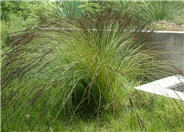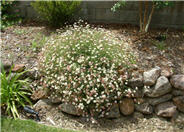
Common name:Small Cape Rush
Botanical name:Chondropetalum tectorum
Chondropetalum tectorum has 3-4' tall stems that shoot out in all directions from the roots. Each stem has papery bracts connected to the ends that turn from tan to dark drown, then fall off. Chondropetalum can grow in marshes, in the ground with regular watering, or in drought conditions.

Common name:Santa Barbara or Mexican Daisy
Botanical name:Erigeron karvinskianus
This low mounding perennial, with fine leaves and white to pinkish daisy-like flowers, is an excellent asset to rock gardens.

Common name:Mexican Blue or Blue Hesper Palm
Botanical name:Brahea armata
This native to Mexico and Baja California displays a dense canopy of stiff fronds contrasted by graceful inflorescences that arch downward and extend well beyond the foliage.

Common name:Common Yarrow, Mifoil
Botanical name:Achillea millefolium
Common Yarrow is a hardy perennial with hairy, evergreen green foliage. It has a tight cluster of white flowers and typically blooms in the summer months. It attracts bees and butterflies. It prefers full to part sun and becomes drought tolerant once it's established. Following bloom, one should dead head the plant and divide the clumps when it appears crowded to keep it looking tidy.

Common name:Common Field or Slender Sedge
Botanical name:Carex praegracilis
This California native grass can tolerate occasional flooding or standing water as it is found in marshes and wetlands. It does make a great lawn substitute as it can be mowed, will take sun and part sun and need watering once a week in hot summer months. This sedge uses much less water than sod. It can be used for erosion control also.
An efficient watering system applies the right amount of water to the right parts of the garden at the right time. This conserves water and saves you money.
Click in the green box for more information
Designer: Cornflower Farms
Photographer: GardenSoft
Practice grass-cycling by leaving short grass clippings on lawns after mowing, so that nutrients and organic matter are returned to the soil.
Attract, or buy beneficial insects such as ladybugs and lacewings to control pest outbreaks in your garden.